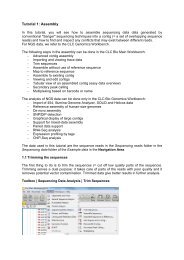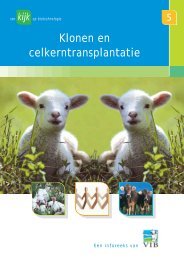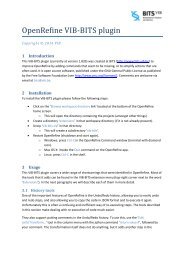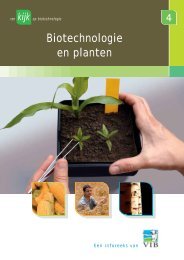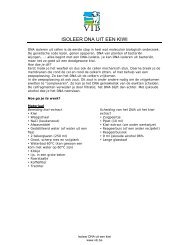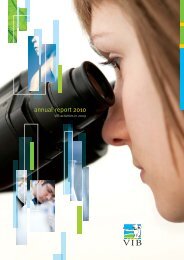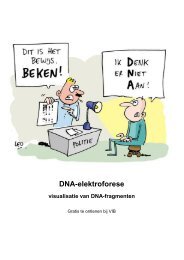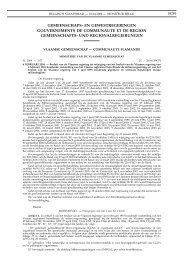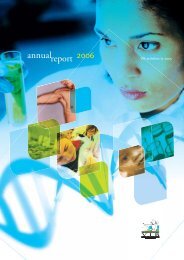Biosafety in the laboratory - VIB
Biosafety in the laboratory - VIB
Biosafety in the laboratory - VIB
Create successful ePaper yourself
Turn your PDF publications into a flip-book with our unique Google optimized e-Paper software.
Work<strong>in</strong>g with genetically modified viruses or viral vectors<br />
Classification<br />
Genetically modified viruses are generally classified <strong>in</strong> <strong>the</strong> same risk class as <strong>the</strong>ir biological<br />
counterparts (see <strong>the</strong> annexes to Vlarem II (www.biosafety.be)), unless <strong>the</strong> <strong>in</strong>sert <strong>in</strong>creases<br />
<strong>the</strong> risk. In <strong>the</strong> latter case <strong>the</strong> modified virus will be classified at a higher risk level than its<br />
biological counterpart. The use of viruses and viral vectors cannot be detached from <strong>the</strong><br />
use of cell l<strong>in</strong>es. This implies that here too <strong>the</strong> comb<strong>in</strong>ation of viral sequences <strong>in</strong> <strong>the</strong> vector<br />
and <strong>in</strong> <strong>the</strong> cell l<strong>in</strong>e should be considered. To produce replication-defective virus particles,<br />
cell l<strong>in</strong>es conta<strong>in</strong><strong>in</strong>g <strong>the</strong> miss<strong>in</strong>g viral sequences needed to create virus particles are<br />
used. Only when <strong>the</strong>re is no risk that replication-competent virus particles might be formed,<br />
<strong>the</strong> virus can be classified at a lower level.<br />
Packag<strong>in</strong>g Viral sequences Vector (by way Classification* Classification Comments<br />
cell l<strong>in</strong>e <strong>in</strong> <strong>the</strong> cell l<strong>in</strong>e of example only) rule**<br />
293 E1 and piece of E1 deleted L2 8 e or j Comb<strong>in</strong>ation of<br />
E4 gene from adenoviral viral sequences <strong>in</strong><br />
adenovirus vector cell l<strong>in</strong>e and vector<br />
may result <strong>in</strong> <strong>the</strong><br />
formation of a<br />
replicationcompetent<br />
virus<br />
PER.C6 E1 gene from E1 deleted L1 9 e or j Zero risk of replicaadenovirus<br />
adenoviral vector tion-competent virus<br />
with no sequence<br />
particle formation<br />
overlap<br />
PA317 Gag-pol-env from Retroviral vector L2 8 e or j Small risk of RCR<br />
amphotrophic lack<strong>in</strong>g <strong>the</strong> formation, though<br />
mouse retrovirus gag-pol-env not unlikely.<br />
genes<br />
Sequence overlap<br />
occurs <strong>in</strong> many cases<br />
psi-CRE Gag-pol and env Retroviral vector L1 7 e or j Risk of RCR formagenes<br />
from lack<strong>in</strong>g <strong>the</strong> tion is smaller than<br />
ecotropic mouse gag-pol-env with PA317.<br />
retrovirus as two genes Moreover, <strong>the</strong> virus<br />
separate constructs<br />
is ecotropic and<br />
<strong>the</strong>refore unable to<br />
<strong>in</strong>fect human cells.<br />
Phoenix- E1/E4 from Retroviral vector L2 8 e or j Risk of RCR formaampho<br />
adenovirus, SV40 lack<strong>in</strong>g <strong>the</strong> tion is smaller than<br />
large T and Gag-pol-env with PA317, but not<br />
episomal gag-pol genes zero, due to <strong>the</strong> epiand<br />
env genes from<br />
amphotrophic<br />
mouse retrovirus<br />
somal presence of<br />
gag-pol and env <strong>in</strong><br />
multiple copies<br />
* on <strong>the</strong> assumption that non-hazardous <strong>in</strong>serts are used (hazardous <strong>in</strong>serts would require a higher risk class)<br />
** as applied <strong>in</strong> <strong>the</strong> schemes of annex 2<br />
Work<strong>in</strong>g with commonly used <strong>laboratory</strong> organisms 41



